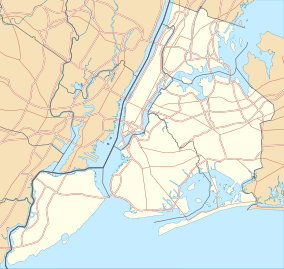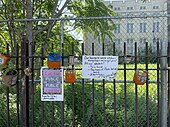
Flatbush is a neighborhood in the New York City borough of Brooklyn. The neighborhood consists of several subsections in central Brooklyn and is generally bounded by Prospect Park to the north, East Flatbush to the east, Midwood to the south, and Kensington and Parkville to the west. The modern neighborhood includes or borders several institutions of note, including Brooklyn College.

The Brooklyn City Railroad (BCRR) was the oldest and one of the largest operators of streetcars in the City of Brooklyn, New York, continuing in that role when Brooklyn became a borough of New York City in 1898.

African Burial Ground National Monument is a monument at Duane Street and African Burial Ground Way in the Civic Center section of Lower Manhattan, New York City. Its main building is the Ted Weiss Federal Building at 290 Broadway. The site contains the remains of more than 419 Africans buried during the late 17th and 18th centuries in a portion of what was the largest colonial-era cemetery for people of African descent, some free, most enslaved. Historians estimate there may have been as many as 10,000–20,000 burials in what was called the Negroes Burial Ground in the 18th century. The five to six acre site's excavation and study was called "the most important historic urban archaeological project in the United States." The Burial Ground site is New York's earliest known African-American cemetery; studies show an estimated 15,000 African American people were buried here.

Shockoe Bottom historically known as Shockoe Valley, is an area in Richmond, Virginia, just east of downtown, along the James River. Located between Shockoe Hill and Church Hill, Shockoe Bottom contains much of the land included in Colonel William Mayo's 1737 plan of Richmond, making it one of the city's oldest neighborhoods.

Prospect Lefferts Gardens is a residential neighborhood in the Flatbush area of the New York City borough of Brooklyn. The community is bounded by Empire Boulevard to the north, Clarkson Avenue to the south, New York Avenue to the east, and Ocean Avenue/Prospect Park to the west. Prospect Lefferts Gardens was designated a New York City Landmark area in 1979 and called the Prospect Lefferts Gardens Historic District.

Teunis Garret Bergen was an American farmer and politician who served one term as a United States representative from New York from 1865 to 1867.

The Lefferts Historic House is located within Prospect Park in Brooklyn, New York City. Built circa 1783, it is the former home of enslaved persons and the family of Continental Army Lieutenant Pieter Lefferts. It currently operates as a museum of the Leffertses' family life in Kings County. The museum is part of the Historic House Trust, owned by the New York City Department of Parks and Recreation and operated by the Prospect Park Alliance. It is a New York City designated landmark.
John Abraham Lott was an American lawyer and politician from New York.

The Flatbush Reformed Protestant Dutch Church, also known as the Flatbush Reformed Church, is a historic Dutch Reformed church – now a member of the Reformed Church in America – at 890 Flatbush Avenue in the Flatbush neighborhood of Brooklyn, New York City. The church complex consists of the church, cemetery, parsonage and church house.

Prospect Cemetery is a historic cemetery located in the Jamaica section of the New York City borough of Queens. It was established in 1668 and known as the "burring plas." The cemetery's original main gate was on Beaver Road which led from Sutphin Boulevard to Jamaica Avenue. The cemetery was generally known as the Presbyterian burial ground and is one of the few remaining Colonial cemeteries in Queens.

The Albemarle–Kenmore Terraces Historic District is a small historic district located in the Flatbush neighborhood of Brooklyn, New York City. It consists of two short cul-de-sacs, Albemarle Terrace and Kenmore Terrace, off of East 21st Street, and the 32 houses on the two streets, as well as a four-family apartment building at the end of Albemarle Terrace. The New York City Landmarks Preservation Commission, which designated the district as a landmark in 1978, noted that the "terraces are distinguished by the uniform use of materials, height and color producing a harmonious effect".

Oakfield Cemetery is a 70 X 438 tract of land located on Oakfield Avenue in Wantagh, New York, in the United States. It is covered with grass and lined with sporadically placed oak trees, and is surrounded by residential homes. Backyard fencing of homes also surrounds the land on both sides. The cemetery is now kept locked to keep vandals out. It was first deeded as a cemetery on March 18, 1851, and is noted as the second cemetery in the area to be used by Black residents of Wantagh, many of whom were descendants of freed Jackson family slaves. It is most noted as being the final resting place of four black Civil War soldiers. The Town of Hempstead takes care of this property. It is nicknamed by area residents as "Indian Burying Ground."
This is a timeline and chronology of the history of Brooklyn, New York. Brooklyn is the most populous of New York City's boroughs, and was settled in 1646.
Rodney Leon is an American architect. He is the founder of Rodney Leon Architect. He is the designer of the monument The Ark of Return, and the memorial for the New York City African Burial Ground National Monument. He specializes in urban planning projects in the United States of America, and abroad, projects with cultural, residential, and religious. He is a member of The Haitian Roundtable (HRT). It is an organization of the Haitian-American professionals committed to civic engagement as well as philanthropic endeavors to benefit Haiti. It was started in 2008.

The Willink Entrance area, also known as Willink Plaza, is a major urban square of Brooklyn, New York City, formed by the intersection of Flatbush Avenue, Ocean Avenue and Empire Boulevard, at the eastern corner of Prospect Park and the southern corner of the Brooklyn Botanic Garden. It is serviced by the New York City Subway's Prospect Park station, and features several public spaces and historic buildings. This location is considered the northwestern point of the Prospect Lefferts Gardens neighborhood of Flatbush, and adjoins Crown Heights to its northeast.

The African American Heritage Trail of Westchester County in New York was created in 2004 to help preserve and interpret the historic landmark places that help tell the narratives of women and men of African descent who have made significant contributions to an American identity. The initial list had 13 sites. Westchester County historian and Schulman History Honoree Dr. Larry Spruill was lead consultant and researcher for the project.
Nicole Hollant-Denis is an American architect, founder and principal of Aaris Design Studios. She is best known for her work on the African Burial Ground National Monument in New York City, for which she won the NOMA Design Excellence Honor Award. Hollant-Denis's other projects include the redesign of La Marqueta Plaza in Harlem, New York.

The Harlem African Burial Ground was a segregated cemetery created in 1668 for the burial of enslaved and freed Africans in the Dutch colony of Harlem. It is located at what is presently 2460 Second Avenue in the East Harlem neighborhood of Manhattan in New York City. It was maintained until 1858 by the Elmendorf Reformed Church, the successor of the Low Dutch Reformed Church of Harlem which founded the cemetery. Although historians of New York and Harlem, as well as church historians, were aware of the cemetery's existence, the East Harlem community was largely unaware of its history until the late 1990s when the New York City Department of Transportation (DOT) began planning the reconstruction of the nearby Willis Avenue Bridge. The investigation revealed that the construction might affect a colonial site and historic burial ground which was under the decommissioned East 126th Street Bus Depot. Per New York State law, the DOT conducted a Phase I-A historical and archeological survey, which verified the existence of the burial ground.





















